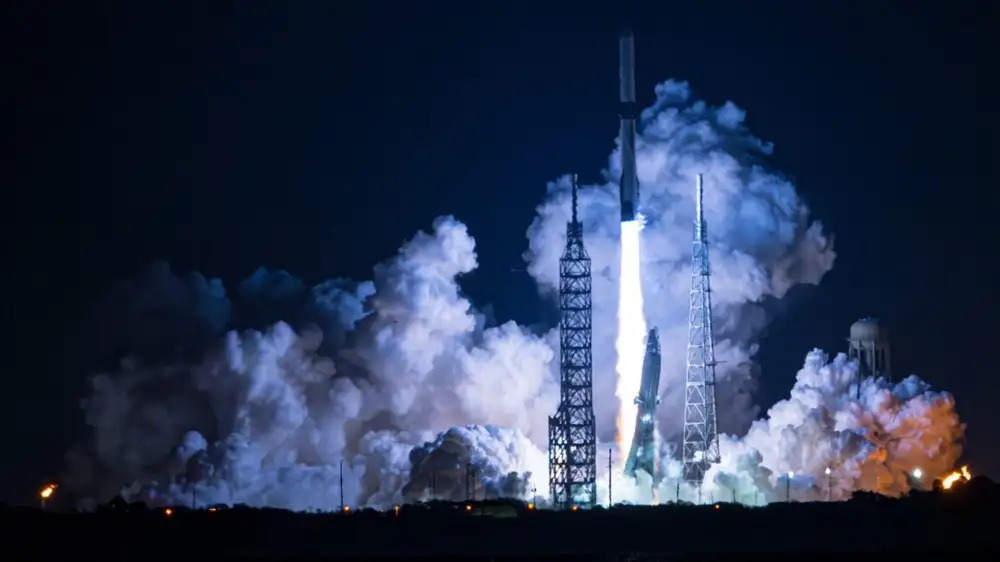Blue Origin is making steady progress toward the second launch of its New Glenn rocket, which could occur sometime this fall.
The company already ignited the second stage of this rocket, in a pre-launch test, in April. And two sources say the first stage for this launch is in the final stages of preparation at the company's facilities in Cape Canaveral, Florida.
Publicly, the company has said this second launch will take place no earlier than August 15. This is now off the table. One source told Ars that a mid- to late-September launch date was "realistic," but another person said late October or November was more likely.
Blue Origin has been mum about the payload that will fly on this rocket, but multiple people have told Ars that the current plan is to launch NASA's ESCAPADE mission on the second launch of New Glenn. This mission encompasses a pair of small spacecraft that will be sent to Mars to study the red planet's magnetosphere.
Who’s on first
This Mars mission was originally supposed to be on New Glenn's first flight in October 2024 but was taken off that flight due to uncertainty in the debut launch date. The issue was that once the two spacecraft were fueled with hypergolic propellant, they needed to be launched within a certain time period.
Had ESCAPADE launched last October, the spacecraft would now be nearing Mars and beginning scientific operations. However, because they missed the Mars "window" last year, they will have to wait for the next one to open late this year. Thus, the nominal plan involves a launch this fall, with the spacecraft now not reaching Mars until later in 2027.
After ESCAPADE, Blue Origin has several missions tentatively plotted out. However, sources cautioned that the manifest could be moved around due to the readiness of subsequent New Glenn vehicles and their payloads.
Based upon information received by Ars, the launch manifest could look something like this:
- New Glenn 2: ESCAPADE (Fall 2025)
- New Glenn 3: Firefly's Elytra orbital transfer vehicle (End of 2025, early 2026)
- New Glenn 4: Blue Moon MK1 lander (first half of 2026)
- New Glenn 5: First batch of 49 Amazon Project Kuiper satellites (mid-2026)
Notably, the company plans to launch each new rocket as soon as it is ready to fly to gather data about the vehicle's performance, attempt to catch and reuse first stages, and move closer to a rapid launch cadence. Therefore, if a customer payload is not ready, the company has also developed an inspirational mission called "Cube for the Future," which appears to be part of the company's initiative to inspire future generations to pursue careers in science. This may also fly as a rideshare on one of the launches listed above.
All eyes on the Moon
Among these missions, the payload likely to spark the most interest is the Blue Moon MK1 lander, which is part of the company's plans to develop a large, reusable lander capable of landing humans on the Moon.
Blue Origin shared a snippet of video last week on social media showing the mid-section of the MK1 lander arriving at the company's assembly facilities in Rocket Park, Florida. This will be the tallest vehicle ever landed on the Moon. It is eight meters (26.4 feet) tall, which is 1 meter taller than the Lunar Module NASA landed humans in during the Apollo Program.
MK1 is a cargo version of a larger vehicle, MK2, that Blue Origin is developing for humans. The cargo version is rated to carry about 3 tons to the metric surface, about 10 times the capacity of currently available commercial landers available to NASA.
Barring a major setback, it now appears highly likely that Blue Origin will beat SpaceX in landing a vehicle on the lunar surface. Due to the struggles with development of the Starship vehicle—whether on the ground or in space, the last four Starship upper stages have been lost before achieving a nominal success—some industry officials believe Blue Origin now has a realistic chance to compete with SpaceX in the effort to land NASA astronauts on the Moon as part of the Artemis Program.
Both companies are developing large, ambitious vehicles—SpaceX with Starship, and Blue Origin with its MK2 lander—but Blue Origin's vehicle is somewhat less technically challenging. Blue Origin founder Jeff Bezos is also far more committed to a lunar program than is SpaceX founder Elon Musk, sources said, and if he sees an opportunity to finally best his rival in space, he may go for it.

 Google scommette sulla fusione mentre le emissioni aumentano
Google scommette sulla fusione mentre le emissioni aumentano